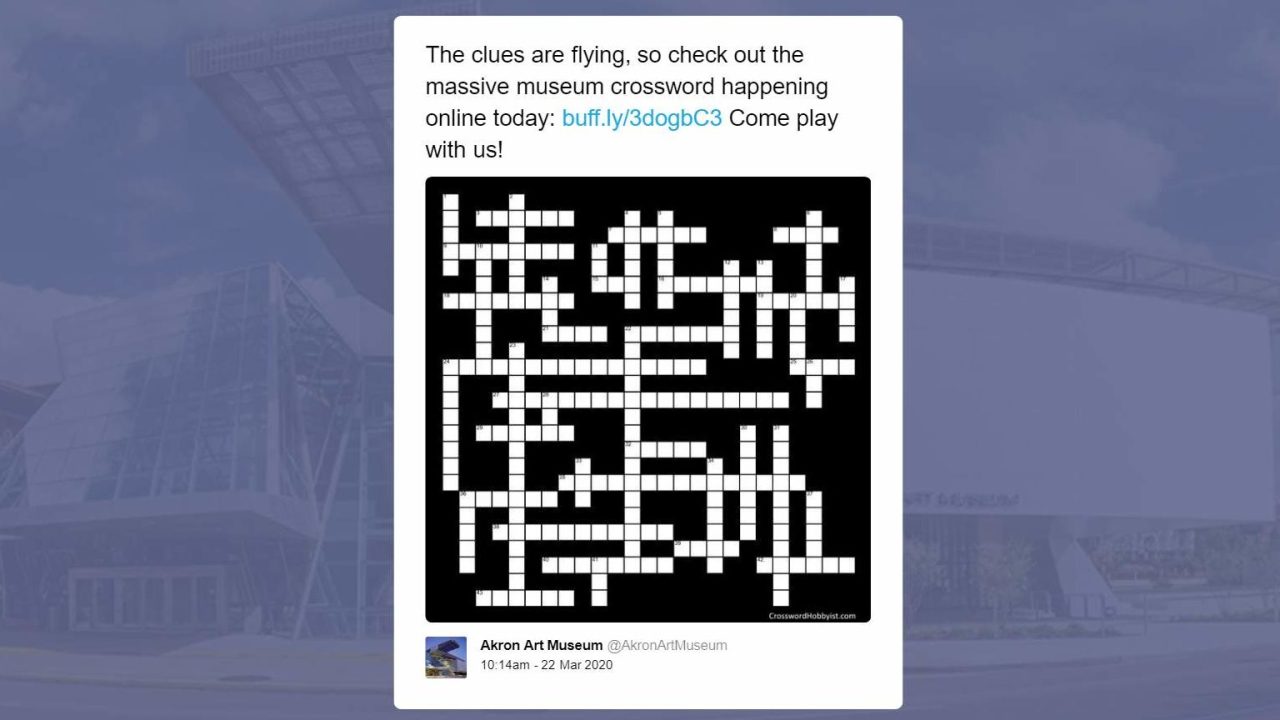
Ever since the rash of closures in response to the COVID-19 pandemic, museums have been working behind the scenes to set strategies for engaging the public through remote alternatives. Within days, two hashtags emerged on social media platforms: #MuseumFromHome and #MuseumMomentOfZen—which speak to the need for education, stimulation, and inspiration during our challenging and confusing times. This past weekend, the Akron Art Museum in Ohio debuted its strategy: a museum spin on the Sunday crossword. Through a Google Doc, the museum is soliciting clues from peer institutions based on their collections, then compiling them into a weekly puzzle.
We asked the Akron Art Museum’s Deputy Director and Chief Experience Officer, Seema Rao, to explain this strategy and the considerations that went into it. Keep your eye on the Alliance Blog for more on these emerging strategies in the coming weeks, and contact us if you have something to share with the field as it plans its response.
More #MuseumFromHome strategies:
- The National Gallery of Art’s social media gallery tours
- Albright-Knox’s artwork showdowns
- The Carnegie Museum of Natural History’s funny TikToks
What is the Akron Art Museum’s #MuseumFromHome strategy?
Even before this pandemic, our approach was to share the good content we create on-site with virtual audiences. Games are something we’ve been doing on social for a few months. Games have also been successfully implemented to on-site audiences. We have an annual juried celebration of game design, GAMEFESTAKRON. We implement games as part of our late-night series, Midwinter Blues & Other Tunes. Our escape room for Midwinter Blues was so popular we sold out in days. So, with the idea that we take core competencies online, our team started working on testing social games. In the last year, our choose your own mystery game and our emoji game were our most popular social offerings.
Sweetness can be an illusion, like in Timothy Horn’s Mother-Load carriage. The candy-coating has been sealed with shellac.
So, your chariot awaits. Where are you off to? pic.twitter.com/qZYcZIkqgt
— Akron Art Museum (@AkronArtMuseum) June 28, 2019
The pandemic added a few new wrinkles to our social strategy: safety and collaboration. Our goal was first and foremost the safety of our staff. As such, we decided we were going to start with existing resources and materials. We didn’t want to go back into the building to produce new videos, for example. Second, the pandemic made us expand our ideas of collaboration. We’d had great success addressing social as an internal cross-functional committee. So, while we could have continued to do museum games on our own, in this pandemic, we took our internal ethos of collaboration to the world. We might be physically isolated, but we wanted to be intellectually and emotionally connected with the world of museums. #MuseumGames was born. It’s enriching to our audiences but also to our team. Playing at work can be the levity we need in this challenging time.
Why do games seem like a good approach?
All of this gameplay onsite and in social media came out of research with audiences. We learned our online and onsite audience wanted to do something: learn, make, play. With this foundation in place, we were ready to adjust when this global situation occurred. While previously our games were short bursts of fun, we decided the audience’s needs have changed. We felt museums could meet the needs of patrons, now with more time on their hands. Meeting our patrons where they are meant adjusting our approach, and we were happy to meet the new needs.
Do you think games can get people to engage deeply with the collections and subject matter of a museum? How do you see that happening? Will you do anything to nudge independent explorations?
We try to allow for engagement as visitors need. While some patrons might need deep engagement, others need snippets of engagement. Games have entertained people for generations, both with quick fun and with broad engagement. Think of the difference between tic-tac-toe and Monopoly. Therefore, museum games can meet the needs of all sorts of patrons.
Games are a great entrée to collections. Independent exploration, and then after that perceived ownership of collections, requires repeated contact. No one can predict what object will spark excitement. The more points of engagement people experience, the more likely they are to find something that makes them want to know more.
Time for a #MuseumGames crossword!
Start with 2 DOWN: Her court case set the legal precedent to abolish slavery in Massachusetts.
Hint: Browse here https://t.co/ebyzzHFEi0Answers: @AkronArtMuseum on Thurs.
Full puzzle: https://t.co/ag94SfYKPY#MuseumFromHome #NYHistoryHere pic.twitter.com/FKtWUQ9KFc— New-York Historical Society (@NYHistory) March 22, 2020
Were there any examples that inspired this strategy, either from other museums or different people or organizations?
I’m happy to say I’ve been working on museum games with colleagues around the country for many years. I can think of countless events and games, like the wonderful Battleship game with collection objects at the Toledo Museum of Art for their Play exhibition and the live-action games we made at the Cleveland Museum of Art for Family Game Night. The Smithsonian American Art Museum, Getty, and SFMOMA were all early innovators in games.
A lot of museums might be thinking collaboratively at this time, about how to share audiences and resources. How do you think collaborations and partnerships could come into something like this?
We, in museums, are all on the same team in a time like this. When resources decrease and stress increases, staff can find support and reach augmentation by connecting with other organizations. Connecting with our audiences in this tough time is imperative and will ensure future survival of the field.
Do you have any more vanguard ideas for #MuseumFromHome strategies at this point, whether games or otherwise? Even totally hypothetical or unfeasible ones?
Vanguard is hard to define. This is a wonderful time of exploration for our field. We’re going to try many things, without giving ourselves the requirement of being on the vanguard. We’re going to do our best and keep meeting audiences. We know that both the new audiences born of social isolation and our current patrons adapting to the new situation are going to have evolving needs. As every museum press release said, we live in unprecedented times. So, our strategies will keep evolving. That said, we will certainly keep play and enjoyment central to our posts.
“The windows of the @CanMusHistory afford a view onto Parliament ___“
This is clue 14 Down for the #MuseumGames crossword, #MuseumatHome.For the full crossword, go to https://t.co/aapQ2KPoRM
Thanks for organizing @AkronArtMuseum! pic.twitter.com/QhOafaeOZ0— Museum of History (@CanMusHistory) March 22, 2020
Thinking positively, since this experience is drawing more attention to non-traditional forms of audience engagement, what do you hope the museum field might learn or gain from this period?
First and foremost, allow people to try things. Give them space to iterate and even fail. Don’t make each attempt make or break. Also, this experience has cemented the idea that all museums need to look outside your organization to your audiences and your colleagues. Give patrons what they want rather than what you wished they wanted.
Finally, what would you suggest to other museums planning their strategies right now?
Let your fear of failure and perfection abate, and throw some stuff together. Start with the premise, ”Yes, let’s make this work” rather than, “No, we don’t do that.” And, remember all of society is living in new circumstances. Museums should take this opportunity to grow—our field depends on it.
Skip over related stories to continue reading article








Comments